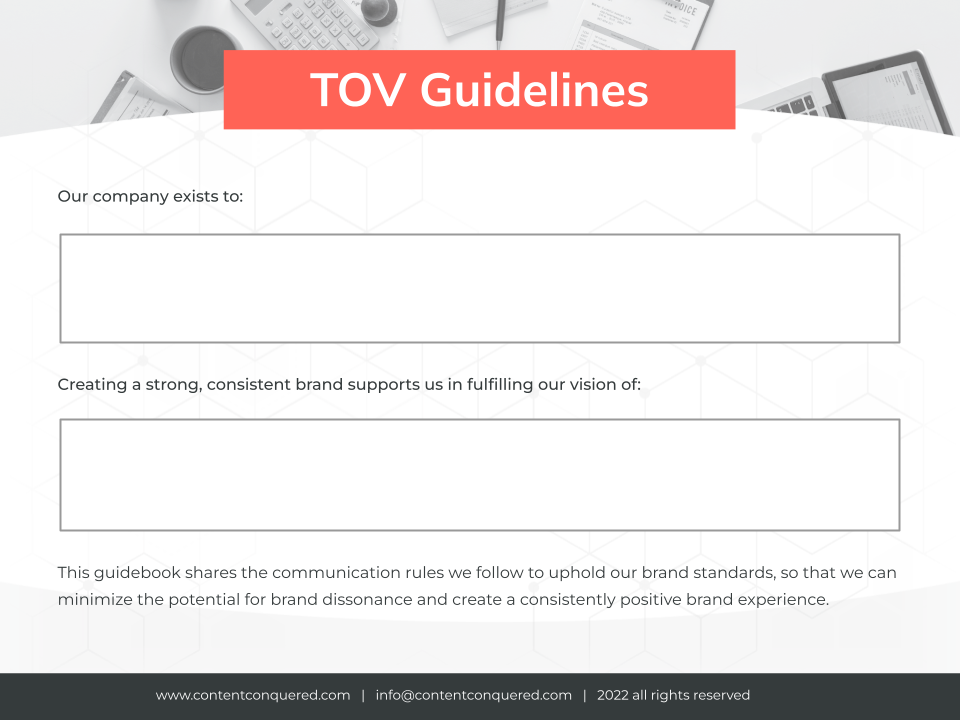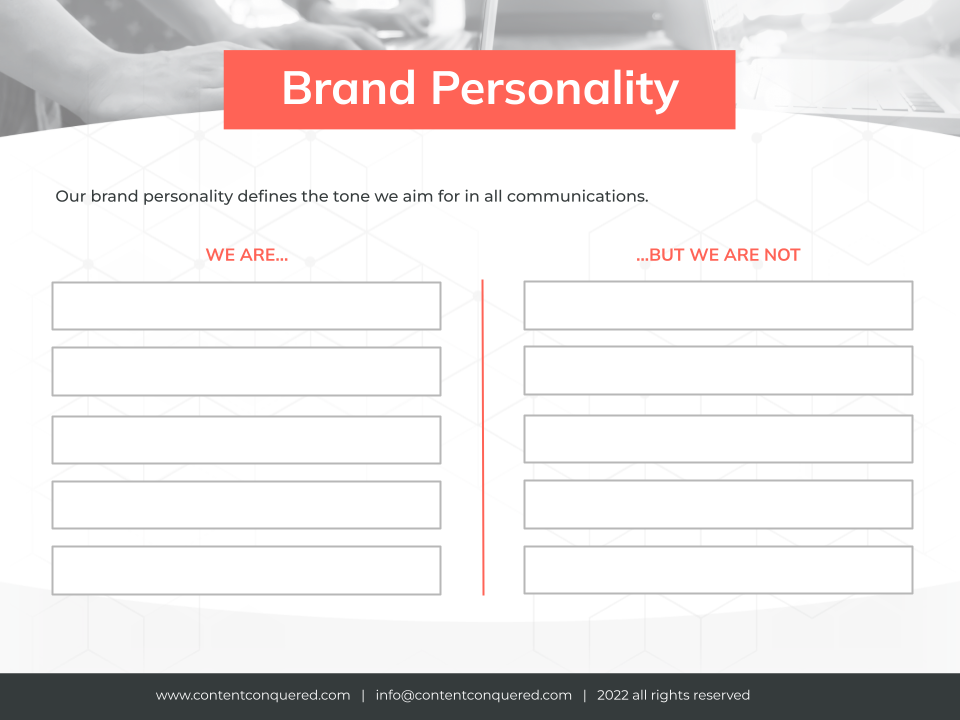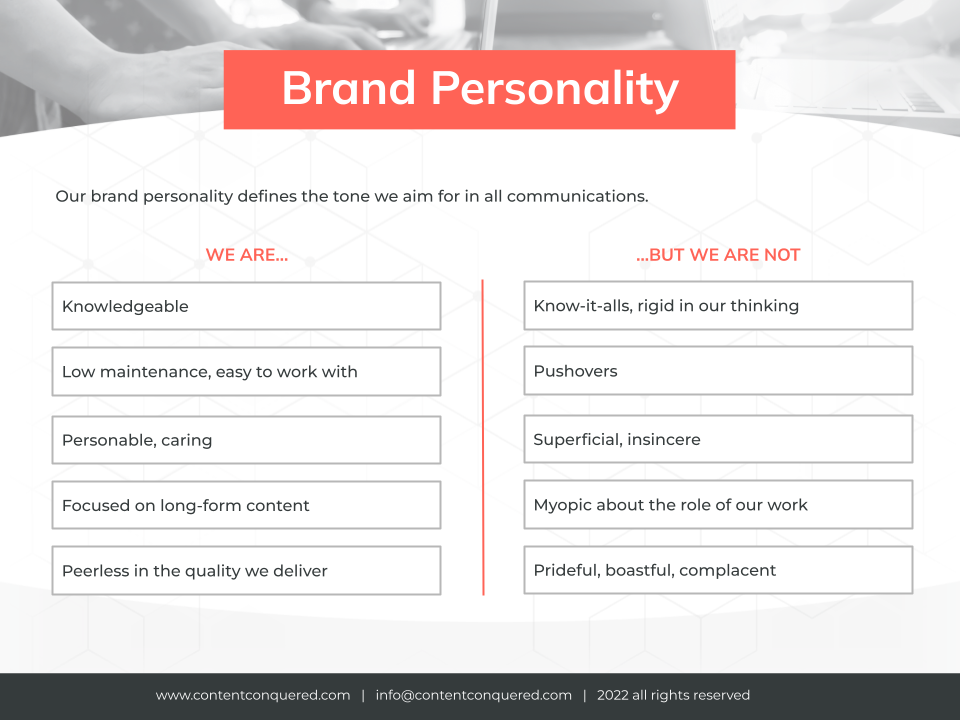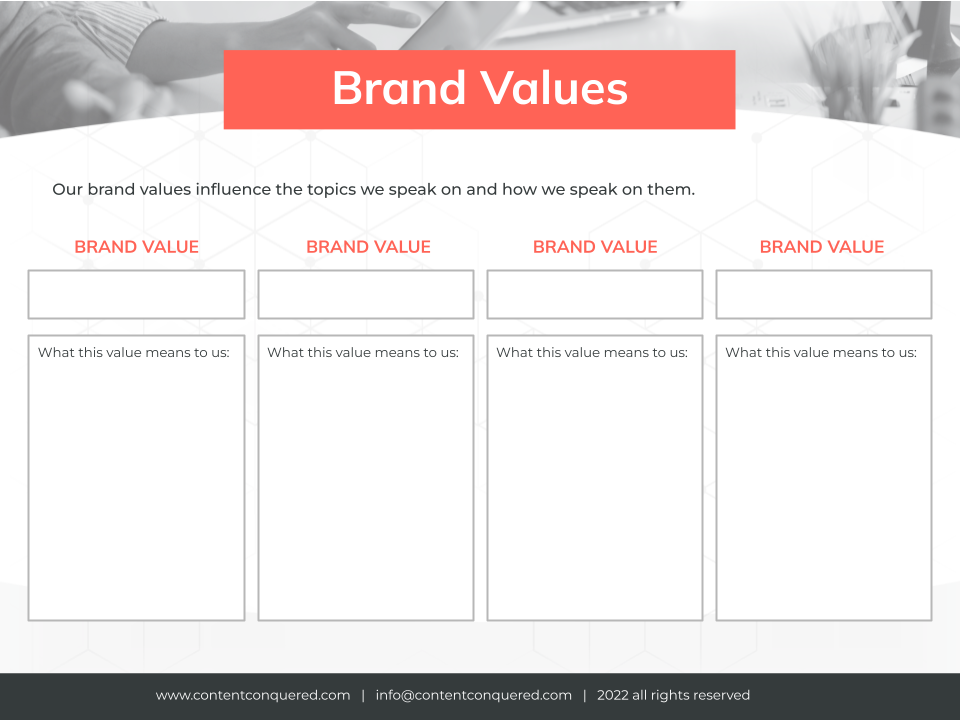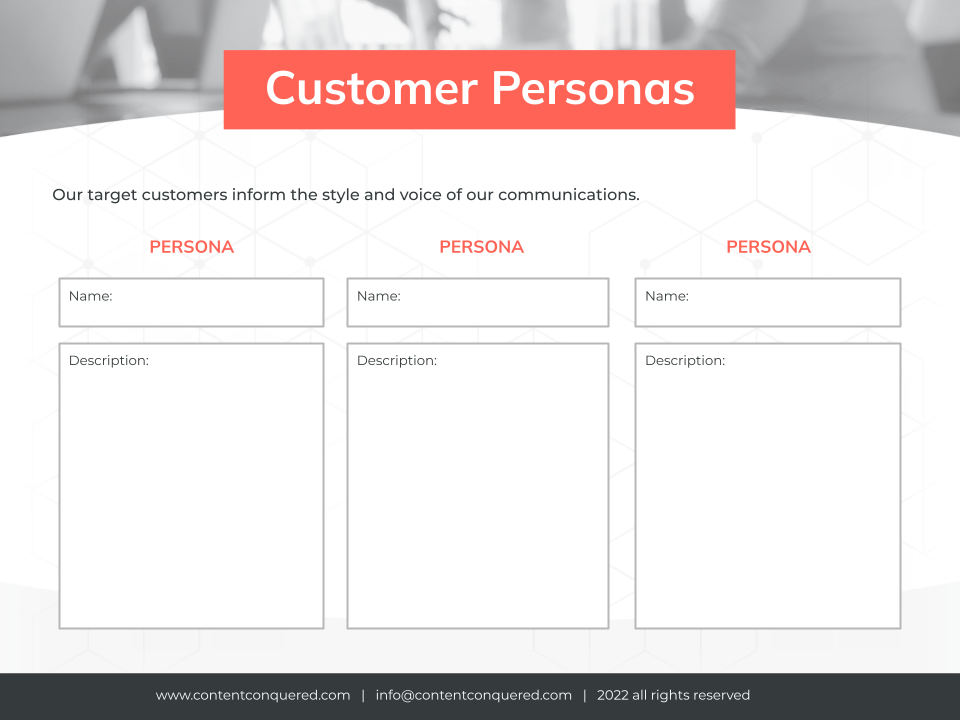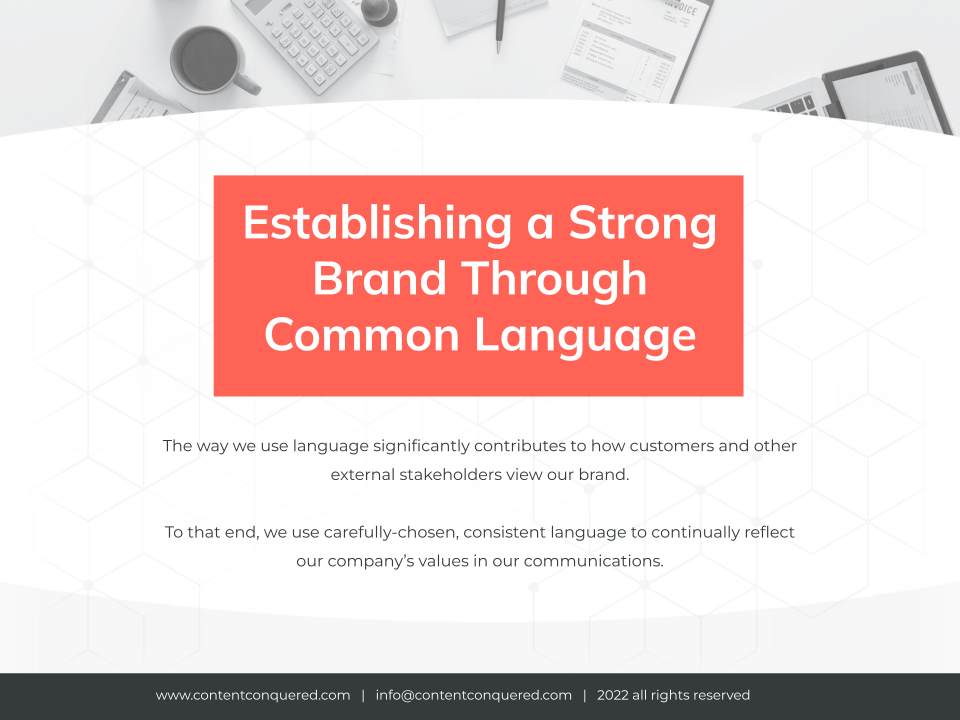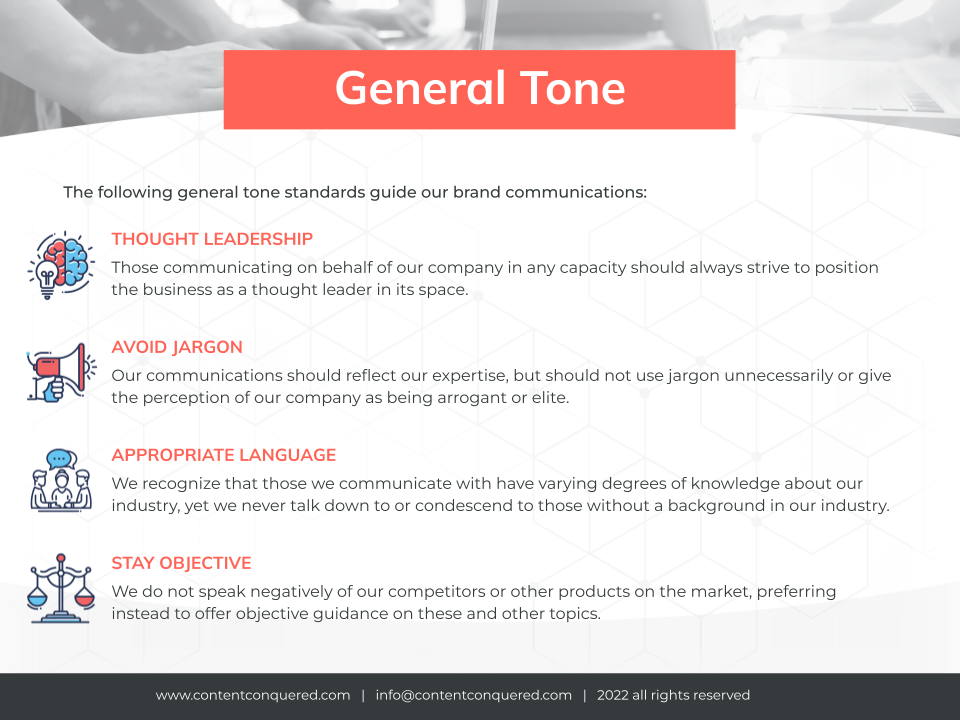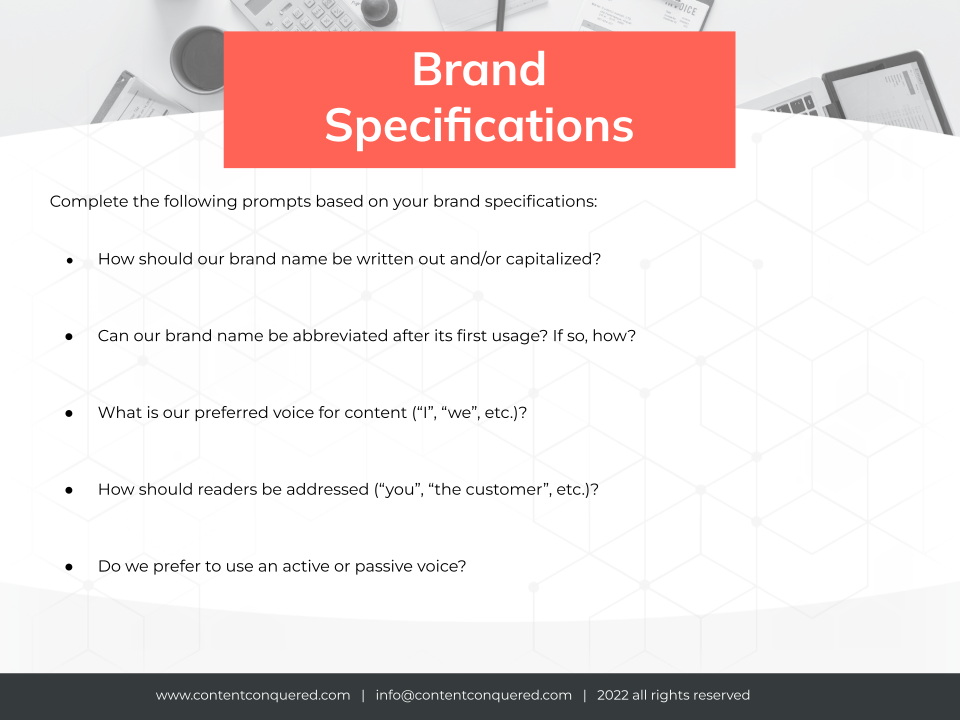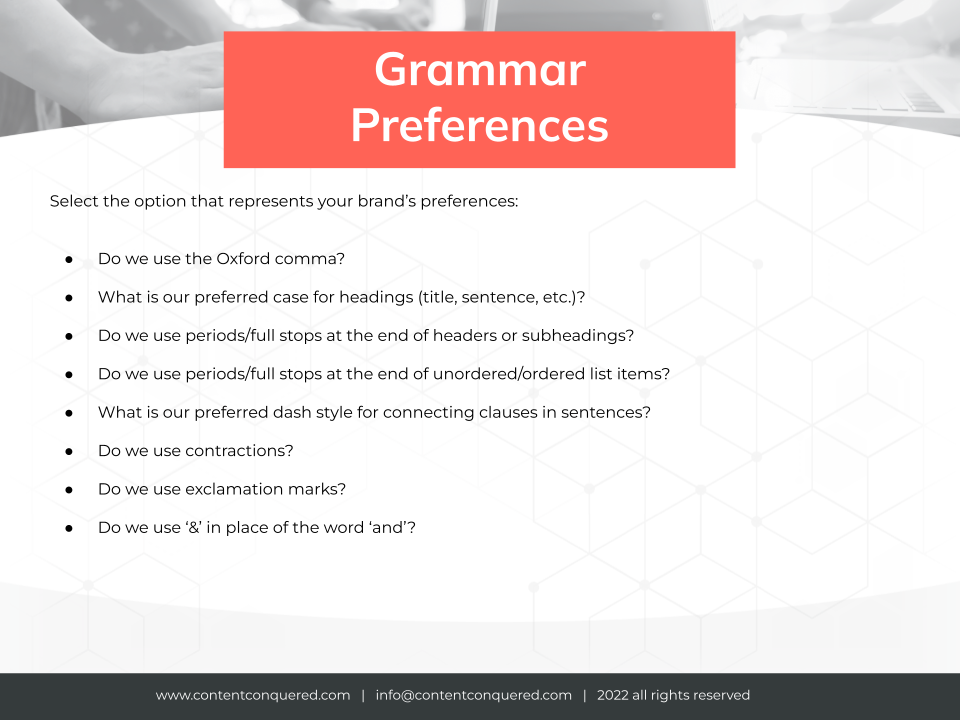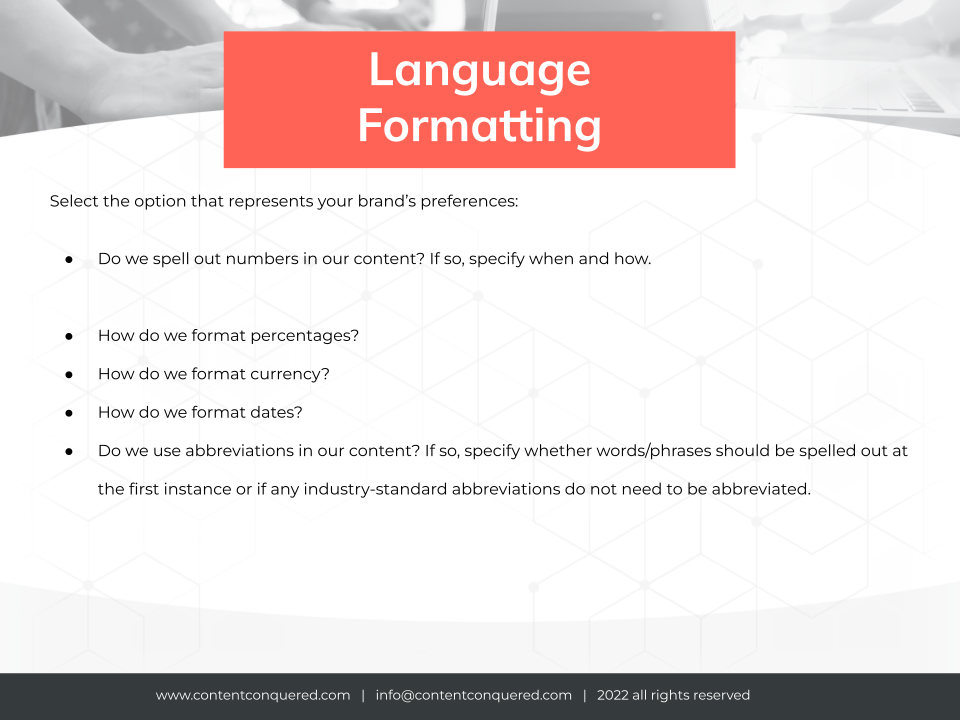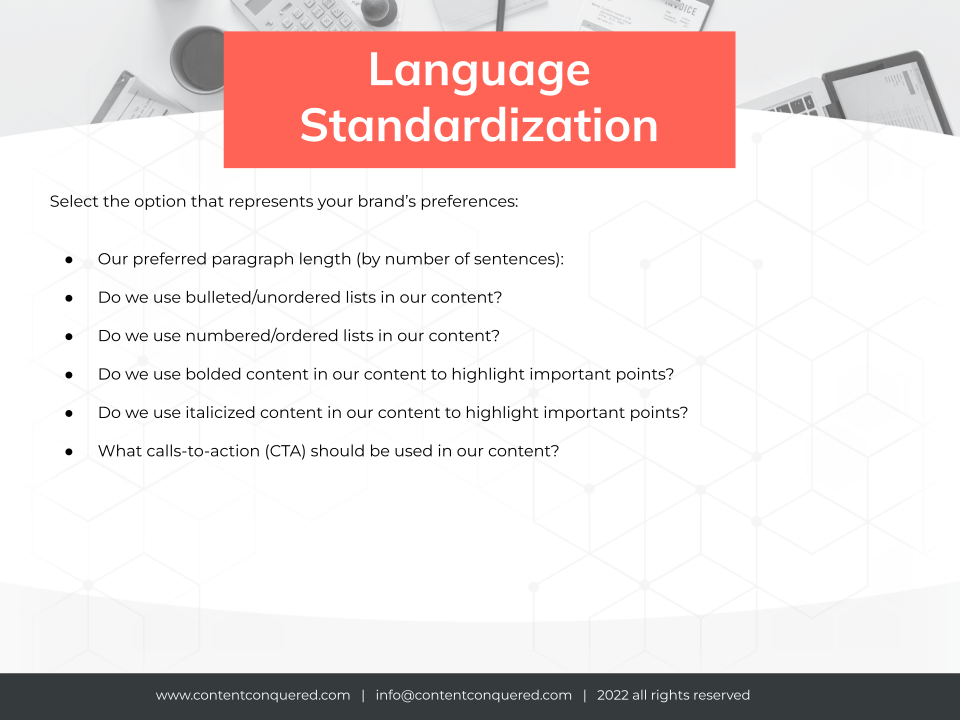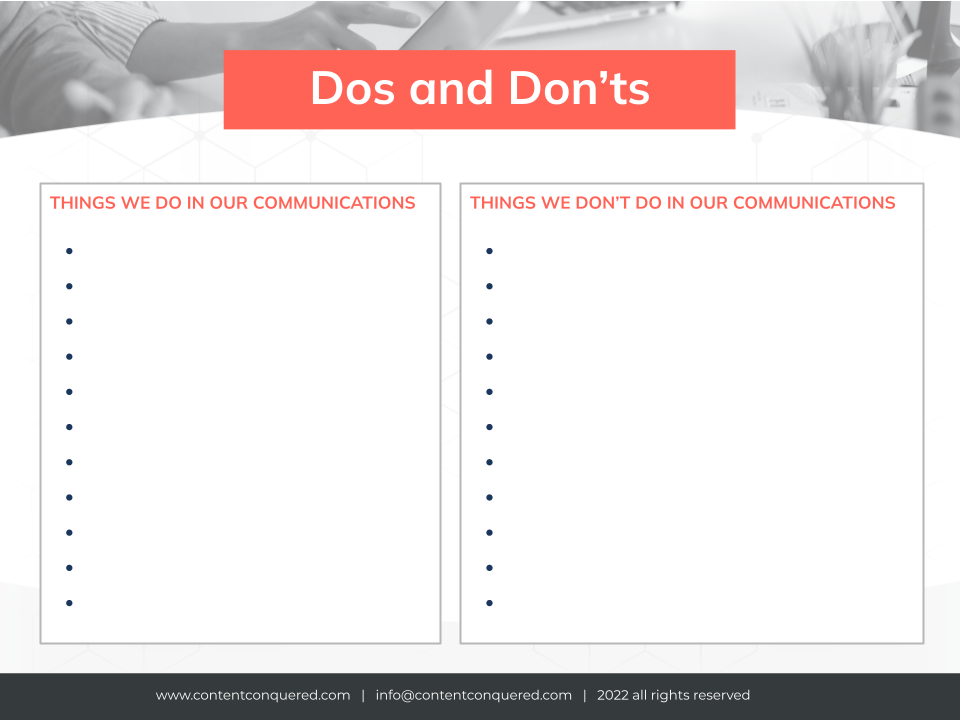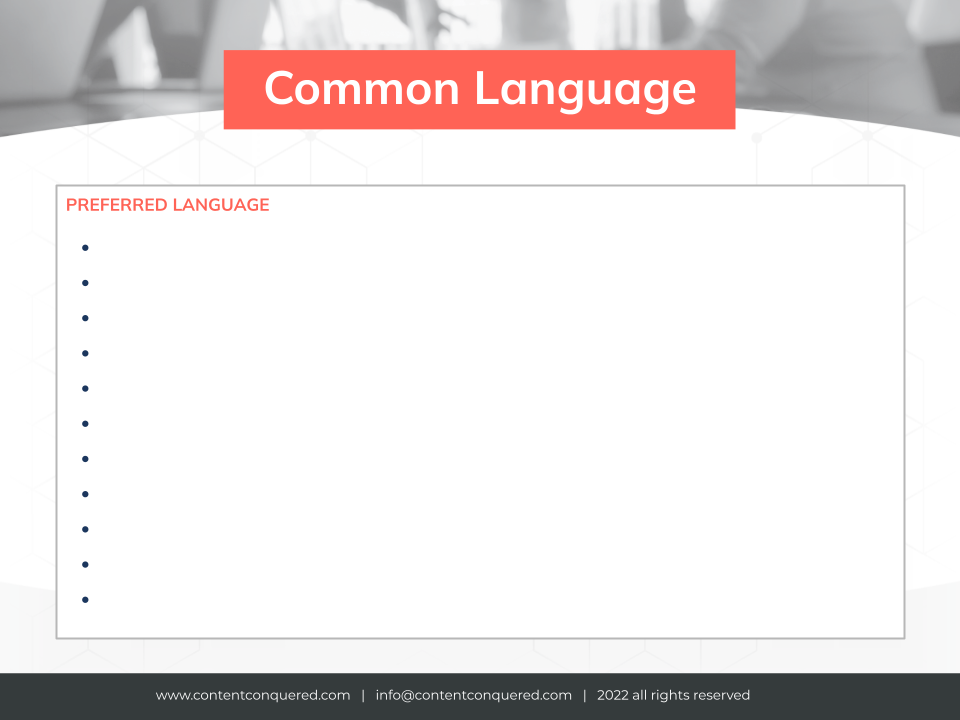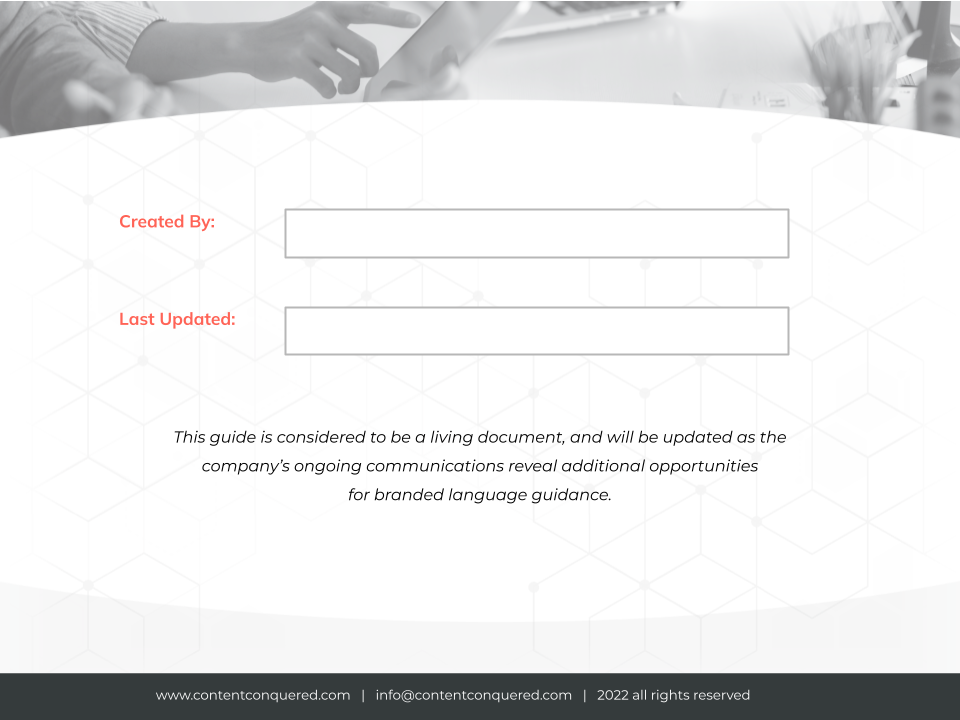How to Create a Brand Tone of Voice (TOV) Guide
Creating a consistent brand experience across channels and platforms is an important part of positioning your company as a memorable, reputable leader within your space.
But when you have multiple internal and external stakeholders communicating on your behalf, getting everyone on the same page can be difficult.
Here’s what you need to know about creating your own TOV Guide.
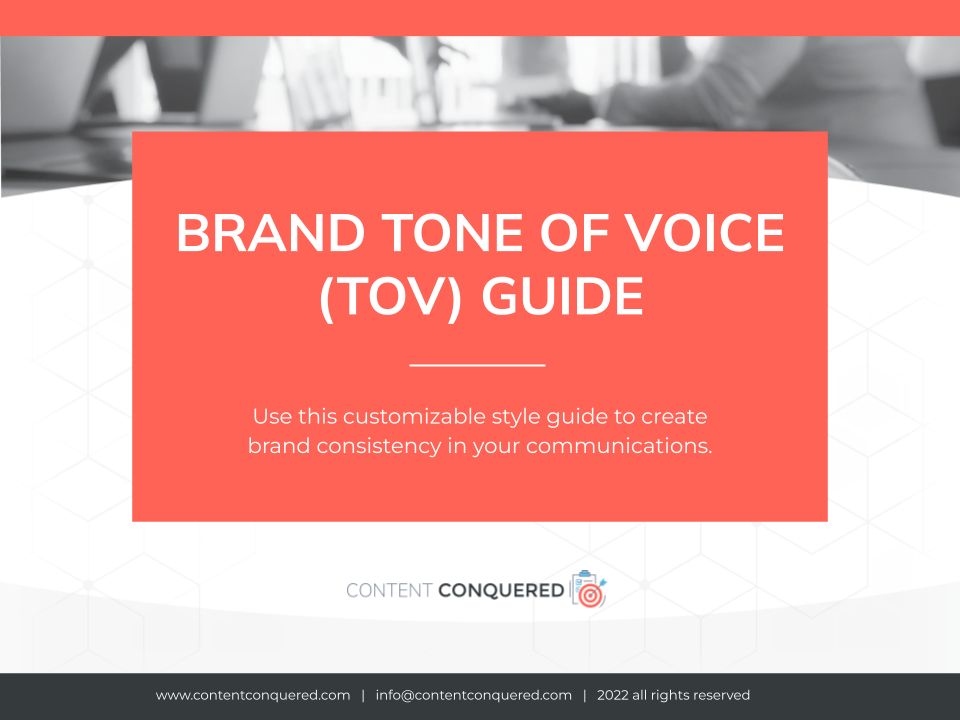
A brand tone of voice (TOV) guide—also known as a brand style guide—unifies your brand’s communications, wherever they’re happening. Whether that means your blog, your website, your social channels, or any other locations, a TOV guide provides a mutually agreed-upon point of reference that everyone can come back to when creating content or producing communications on behalf of the brand.
Yet, despite these and other benefits, many companies don’t have a brand TOV guide in place—even those that do may not use it regularly or consistently. If you’re in this position, read on for more on how to build and implement your own TOV guide.
What is a Brand TOV Guide?
How to Create a Brand TOV Guide
Establishing a Strong Brand
Gaining Buy-In for Your Brand Guide
What is a Brand TOV Guide?
A TOV guide can take many different shapes. Maybe it’s a formal slide deck that showcases your brand’s language preferences in a beautifully designed format. Maybe it’s just a shared Google Doc that contributors can access as needed. In any case, the final format of your TOV guide is less important than what’s in it, how it’s created, and how it’s used.
Ultimately, a TOV guide is the output that results from a team coming together in agreement on how a brand should be positioned publicly. The act of creating the guide is a powerful way to make sure everyone’s aligned, that everyone understands what the brand represents, and that everyone knows how to communicate on its behalf.
Going through this process is especially important if you have external writers, content creators, or communicators working on your behalf. Whether that’s an individual freelancer or a content creation agency like Content Conquered, being able to provide direction in this way helps get them up-to-speed more quickly and increases the odds that they’ll be able to successfully communicate on your behalf.
How to Create a Brand TOV Guide
If you don’t already have a brand TOV guide, you can use the template we walk through with Content Conquered clients when we create editorial guidelines on their behalf:
After you’ve downloaded the template, follow along with the rest of this article to learn how to fill it out. Make sure you bring any necessary stakeholders into the process of filling out the template. Depending on your organization, members of the marketing, sales, customer service, product, development, and leadership teams may need to be involved.
Brand Background
When we create a brand TOV guide for a Content Conquered client, we start by capturing some very high-level thinking around who the company is.
TOV Guidelines
On the first page of the template, you’ll find a space to include a few notes about the purpose of your company, as well as what your vision is.
We start with the purpose of your company because having a strong, consistent brand makes it easier to execute your brand’s vision.
Just imagine that you encountered Nike products for sale without the company’s familiar swoosh. Even if your brand isn’t as widely known or memorable as Nike’s, consistency matters. If people encounter different messaging in different places, this dissonance can lead to confusion or to the perception that your brand isn’t that strong.
If you already have a vision statement, copy and paste it into the template. If you don’t, spend a few minutes thinking about the purpose of your company and how having a strong brand voice supports you in that vision, and then add your notes to this slide.
Brand Personality
Next, we move into brand personality. This exercise might feel a little different from how you’re used to thinking about your brand—especially if you’ve ever done the work of brainstorming adjectives to describe your brand’s personality or voice before.
What we try to do is to define not just what the company is, but also what it’s not. Ultimately, both sides of that equation are going to influence the way that the brand should communicate.
Here’s what the output of this exercise will look like:
This exercise is easier to understand with an example. Here’s Content Conquered’s current brand personality statement:
As you can see:
- One of our brand’s core personality traits is that we’re knowledgeable, but at the same time, we’re not rigid in our thinking. We have a tremendous amount of content creation expertise within our organization, but that doesn’t mean that we should come to a client’s project inflexible and unwilling to work in a collaborative way.
- We try to be low-maintenance and easy to work with. We go to pretty great lengths to create an effortless experience when working with our team—we offer a lot of high-touch service elements and personalized approaches, depending on how companies prefer to work with us to create content. But at the same time, we aren’t pushovers. We’re here to bring our knowledge and expertise to a client’s work. Sometimes, that means taking a leadership role, and sometimes it means taking a step back. In any case, we never want to allow ourselves to be pushed over or steamrolled by a client.
- As a brand, we consider ourselves to be personable and caring. This comes out of our deep commitment to supporting our clients’ needs and our genuine care for the outcomes of the content that they create. But at the same time, we don’t want the way we come across as a brand to feel superficial or insincere. We need to be constantly willing to challenge ourselves and confirm that we’re operating in an authentic way.
- We are focused on long-form content. As a content creation agency, we don’t get into social media, video content, or other forms of content because that’s not where our expertise lies. But at the same time, we aren’t myopic about the role that our work plays in the broader context of marketing. Just because we’re focused on long-form content doesn’t mean that we don’t also understand how all types of content support a company’s overall marketing and business goals.
- We aim to be peerless in the quality of the content that we deliver. That’s why we continually invest in making ourselves better by attracting better writers or developing better internal systems and processes. But at the same time, we don’t want to be prideful or boastful about the quality of our work. We also try not to be complacent. We’ve developed a very high-quality service, but that doesn’t mean we allow ourselves to rest on our laurels and be content with what we’ve done. We’re always striving to be just a little bit better than we were the day before.
Hopefully, this gives you an idea of what a brand personality statement can look like—even if the guard rails you choose are very different from ours. To create your own, we recommend the following process:
- Step #1: Brainstorming. Sit down as a team—including all of the appropriate stakeholders within your company—and start by brainstorming a giant list of all the qualities that might sit in the ‘We Are’ section. Most organizations find that it’s easy to come up with at least 20-30 ideas, if not more.
- Step #2: Group your finalists. Next, narrow the list down to five or fewer finalists (or more, if you really need them). What we’ve found is that, at this point, it’s really easy to group your big list of ideas into smaller lists of related words or phrases. For example, ‘casual,’ ‘informal,’ and ‘conversational’ all share a similar meaning and can likely be grouped together to help ensure each of your finalists communicates something different.
- Step #3: Identify your winners. From any small groups you’ve created, select the single word or phrase that you feel best represents how you as a team see your brand personality. This may take some thinking, or you might find that clear winners emerge from your smaller groups.
- Step #4: Identify potential risks. Once you’ve selected your finalists, start to brainstorm the potential shortfalls or risks that might go along with the qualities you’ve selected and add them to the ‘We Are Not’ section.
Take some time to play around with your selections, but don’t feel like you have to nail this 100% right away. The goal is to establish a working definition of your brand’s personality that can serve as a guard rail around your brand, but you can always come back and iterate it later. For now, just aim to get something done and on paper.
Brand Values
Next up are your brand values. Not every company defines these, but if you do, capturing them in your brand’s TOV guide is a good way to add more context to your overall tone of voice direction.
If you have predefined values as a company, list them here, along with a short description of what that value means to you and your company. If you have more than four values, you can always duplicate this page, but don’t feel you need to put a lot of new thought into your values at this point. If you don’t have defined values, just skip or delete this page.
Customer Personas
Additionally, if your brand has defined customer personas, use the next slide to include them in your brand TOV guide.
Even if you don’t have predefined customer personas, we still recommend adding a few details to this page. That’s because it’s easier to create great content when you can picture your target reader in your mind and write as if you’re speaking directly to them.
If you don’t want to undertake a full persona development exercise, just imagine that you’re telling someone who’s new to your company or who’s new to creating content on your behalf about the kinds of people you sell to. Try to create a quick reference on your customers’ qualities and characteristics that they can come back to as they’re working.
Establishing a Strong Brand Through Common Language
Now that we’re through with the background information, let’s move into the more granular guidance that goes into establishing a brand’s tone of voice.
While there’s nothing for you to fill out on this page, we include it to reiterate that the reason we’re choosing to define a brand tone of voice in the first place: that the way we use language contributes to how customers, external stakeholders, vendors, and others outside of the company view the brand.
General Tone
On the next slide, you’ll find a few general guidelines we typically recommend as being appropriate for most companies.
These general tone guidelines include:
- Thought Leadership: Building perceived authority means making sure that, whenever we’re communicating in any capacity, we’re contributing to the perception that the company is a thought leader in its space.
- Avoid Jargon: At the same time, we want to avoid jargon. While it’s ok to use technical language when appropriate—especially if it’s needed to convey that sense of thought leadership we’re seeking—we also don’t want to use language members of our audience won’t understand. Using excessive jargon, acronyms, or other specialized language could also create the perception that the brand is arrogant or elite. Unless that’s what you’ve defined as your brand’s personality, check that your language is accessible by all members of your target audience.
- Appropriate Language: We also want to recognize that the people who are engaging with our content and our communications all have different degrees of knowledge about our industry. Even if we’re trying to position the company as a thought leader, we still want to make space for those who are new to the industry or our chosen subject matter.
- Stay Objective: Finally, the last recommendation we make is to stay objective. Typically, we recommend that companies speak objectively about other products on the market and other competitors. Being deliberately negative can come across as petty and risks compromising the sense of objective authority we want to convey.
Again, these are just a few general tone guidelines that we’ve found are appropriate for almost all of the companies that we work with. If they’re not appropriate for you, feel free to take this slide out or create your own.
Language Standardization
These next four slides represent the start of the language standardization process, which aims to ensure that the output of all of your content creators shares important similarities.
If you haven’t done this type of exercise before, spend some time thinking through the options that best reflect the way you want to portray your brand in your communications.
The list of prompts here includes some of the questions we go through in our new client intake process at Content Conquered, and it’s important to note that they’re very open-ended. There’s no right or wrong here, as much as there is a need to capture what exactly you want your content creators to do.
Also, keep in mind that you may want to create multiple versions of these slides.
For example, imagine that your team will be producing public-facing content on behalf of your company’s CEO and your marketing director. If your CEO uses a more formal tone of voice than your marketing director, you may need to go through this process twice or add notes to your slides to capture the differences in how you want them to communicate publicly.
Dos and Don’ts
This slide is optional, but if there are any places where you want to expand on things you do or don’t do in your content—beyond what was covered in the ‘Language Standardization’ slides—add this information here.
The following are a few examples of what you might include here:
We Do:
- Try to back up our content with research that’s timely and developed by reputable sources
- Always write out the United States as ‘U.S.’ and never as ‘US’
- Allow sentences that start with ‘And,’ ‘But,’ or ‘Or’
We Don’t:
- Use metaphors, expressions, or colloquialisms that might not be understood by non-native readers
- Use the word ‘trustworthy’ when describing ourselves
- Use the phrase ‘nigh-on impossible’
That last one might seem a bit obscure, but it’s an actual style note we captured from a Managed Content Service client in their intake process!
This really emphasizes why it’s so important to put the time into developing a custom brand TOV, since every company is so different. A standard style guide you find online won’t be able to capture your brand’s unique voice and preferences—or distaste—for certain phrases.
Common Language
The Common Language slide is one final place to capture guidance on the way you want creators to communicate on behalf of your brand.
For example, if there is industry-specific terminology for which you want to ensure consistent usage, record it here. If you describe your service in different ways than your competitors, make those distinctions here.
This is also a good place to record any specific capitalization schemes used in your brand name or product/service names. For example, our team did some work for a company that never capitalizes the first letter in its brand name. Capturing this preference in their brand TOV guide made it easy to quickly get writers on the project up-to-speed on their requirements.
Production Notes
Finally, we always encourage clients to think of their tone of voice guide as a living document. The way that you create content and communicate may evolve over time, which is why we include this final slide to mark down who worked on the document and when it was last updated.
If your TOV guidance changes, come back and update your guide so that you always have the most current version ready for anyone who’s working on content or communications on your behalf.
Gaining Buy-In for Your New Brand TOV Guide
Once you’ve taken the time to create a shiny new TOV guide that perfectly encapsulates your brand’s personality, make sure your effort isn’t wasted by ensuring you gain buy-in on actually using it.
Here are a few tips for doing so:
- Make sure that any relevant stakeholders are included from the start. Creators are much more likely to follow guidelines if they have a hand in building them and understand why different choices were made.
- Store your finished TOV guide in a place that’s memorable and easily accessible to all of your communicators. Don’t make them dig through endless emails or file storage systems just to find the rules they need to follow!
- Give one person (or one department) at your company ownership over ensuring brand voice standards are properly executed across all channels. At first, this may take a little extra effort, as content and communications will need to be read more closely and corrected more frequently. But taking the time to do so from the start makes it easier for creators to understand your expectations and get on board more quickly.
- Proactively seek out creators who can match your preferred style. If you partner with external content vendors, having a defined brand TOV means you’ll be better able to determine whether a writer’s natural style aligns with what you’re looking for. By seeking out talent that matches your preferences, you’ll cut down on both revision time and frustration.
- Revisit your guide if issues arise. If you continually run into the same issues around staying in compliance with your TOV guide, it may not be your creators that need to make a change – it may be that your TOV guide should be adjusted to suit the natural voice being developed. Never be afraid to go back and make changes, where appropriate.
Need Help Creating Your Brand TOV Guide?
If you’d like additional support going through the process of creating a TOV guide, Content Conquered’s Brand Voice Workshop can help through a guided, collaborative process that leads you through these and other questions to define your ideal brand voice.
While any organization can use the downloadable template to create a TOV guide, we find that some businesses benefit from:
- Working with an experienced facilitator that understands how to integrate feedback from multiple sources and stakeholders
- Leadership from an external source that ensures the project doesn’t fall off people’s calendars as other priorities arise
- A team that can draw on past client workshops and industry best practices to bring a broader perspective to the exercise
If any of that would be helpful for your company, reach out for more information on the Brand Voice Workshop. Not only can our experienced team guide you through the process—making the creation of your Brand TOV Guide seamless and pain-free—we’ll even put your new guidelines into a custom-branded slide deck you can share with your whole team.
Reach out with questions about Content Conquered’s Brand TOV Guide or get started with your custom Brand Voice Workshop:

